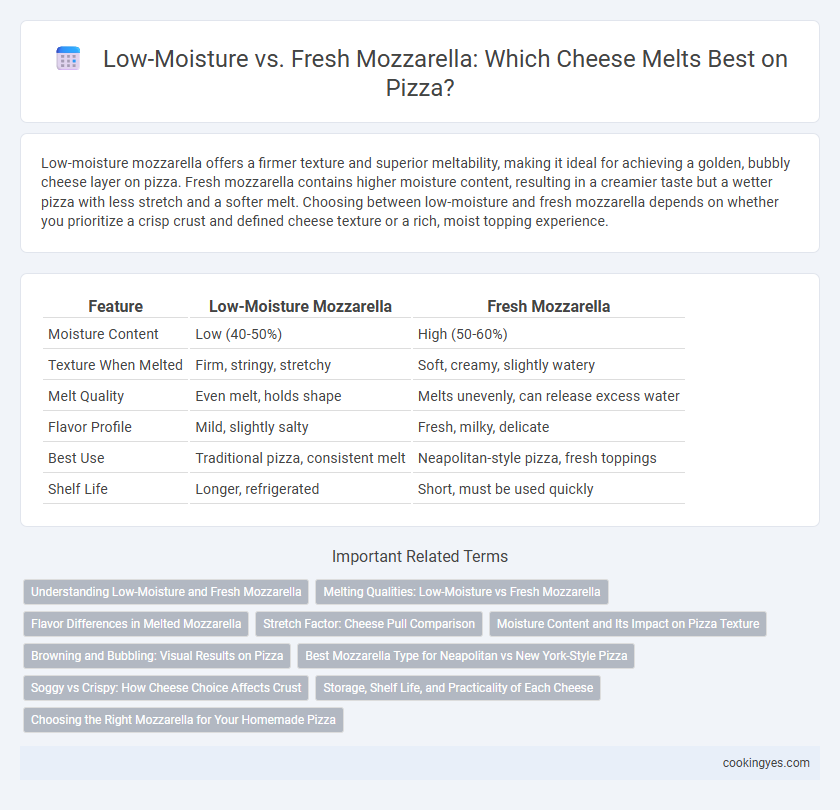Low-moisture mozzarella offers a firmer texture and superior meltability, making it ideal for achieving a golden, bubbly cheese layer on pizza. Fresh mozzarella contains higher moisture content, resulting in a creamier taste but a wetter pizza with less stretch and a softer melt. Choosing between low-moisture and fresh mozzarella depends on whether you prioritize a crisp crust and defined cheese texture or a rich, moist topping experience.
Table of Comparison
| Feature | Low-Moisture Mozzarella | Fresh Mozzarella |
|---|---|---|
| Moisture Content | Low (40-50%) | High (50-60%) |
| Texture When Melted | Firm, stringy, stretchy | Soft, creamy, slightly watery |
| Melt Quality | Even melt, holds shape | Melts unevenly, can release excess water |
| Flavor Profile | Mild, slightly salty | Fresh, milky, delicate |
| Best Use | Traditional pizza, consistent melt | Neapolitan-style pizza, fresh toppings |
| Shelf Life | Longer, refrigerated | Short, must be used quickly |
Understanding Low-Moisture and Fresh Mozzarella
Low-moisture mozzarella contains less water content, allowing it to brown more easily and produce a firmer, stringier melt ideal for classic pizza toppings. Fresh mozzarella, often sold packed in brine, has higher moisture levels that result in a creamier texture and a softer, more delicate melt, perfect for Neapolitan-style pizzas. Understanding the moisture differences helps pizza makers choose the right cheese to achieve their desired melt texture and flavor profile.
Melting Qualities: Low-Moisture vs Fresh Mozzarella
Low-moisture mozzarella melts evenly and creates a stretchy, gooey texture ideal for traditional pizza styles, thanks to its reduced water content and higher fat concentration. Fresh mozzarella contains higher moisture levels, resulting in a softer, creamier melt that can release excess water, potentially causing sogginess on the crust. For optimal cheese melt with minimal moisture release, low-moisture mozzarella remains the preferred choice in achieving consistent stretch and browning on pizza.
Flavor Differences in Melted Mozzarella
Low-moisture mozzarella offers a stronger, more concentrated flavor and creates a stretchier, more uniform melt ideal for traditional pizza styles. Fresh mozzarella has a milder, creamier taste with higher moisture content, resulting in a softer, more delicate melt that releases more whey during baking. The choice between these types significantly affects the pizza's overall flavor profile and texture after melting.
Stretch Factor: Cheese Pull Comparison
Low-moisture mozzarella offers a superior cheese pull with a longer, more elastic stretch due to its low water content and higher fat concentration, making it ideal for achieving the classic pizza cheese melt. Fresh mozzarella, while creamier and softer, tends to release more moisture during baking, resulting in a shorter, less elastic stretch and a more tender cheese pull. Selecting low-moisture mozzarella enhances the cheese melt's visual appeal and texture, especially for traditional or Neapolitan-style pizzas seeking that iconic stretchy cheese factor.
Moisture Content and Its Impact on Pizza Texture
Low-moisture mozzarella contains around 45-52% moisture, resulting in a firmer texture and less oil release when melted, making it ideal for achieving a stringy, chewy cheese pull on pizza. Fresh mozzarella has a higher moisture content, typically 60-65%, which creates a creamier, softer melt but can sometimes lead to a wetter pizza crust due to excess moisture. Choosing between low-moisture and fresh mozzarella significantly affects pizza texture, with moisture content directly influencing cheese stretchability, melt consistency, and crust integrity.
Browning and Bubbling: Visual Results on Pizza
Low-moisture mozzarella offers superior browning and bubbling on pizza due to its lower water content, which prevents excessive moisture release during baking and promotes a golden, slightly crispy cheese crust. Fresh mozzarella, with higher moisture content, melts into a creamy, silky layer but tends to produce less browning and more watery bubbling, often resulting in a softer, less visually defined cheese surface. Choosing low-moisture mozzarella enhances traditional pizza aesthetics with well-defined bubbles and caramelized spots that create a more appealing melt.
Best Mozzarella Type for Neapolitan vs New York-Style Pizza
Low-moisture mozzarella offers a firmer texture and longer melt, making it ideal for New York-style pizza, which requires a chewy, stretchy cheese layer that holds its shape well under high heat. Fresh mozzarella contains higher moisture content, resulting in a creamier, softer melt that complements the thinner, wood-fired crust of Neapolitan pizza by providing a rich, bubbly topping without overpowering the delicate dough. Choosing low-moisture mozzarella enhances the classic New York pizza experience with its robust melt and flavor retention, while fresh mozzarella delivers authenticity and balance to the traditional Neapolitan slice.
Soggy vs Crispy: How Cheese Choice Affects Crust
Low-moisture mozzarella offers a firmer texture and lower water content, which helps maintain a crispy pizza crust by preventing excess moisture from seeping into the dough. Fresh mozzarella, with its higher moisture level, tends to release more water during baking, often resulting in a soggy crust that lacks the desired crispiness. Choosing low-moisture mozzarella is essential for achieving a balanced cheese melt without compromising the pizza's crust texture.
Storage, Shelf Life, and Practicality of Each Cheese
Low-moisture mozzarella offers a longer shelf life, typically up to six weeks when refrigerated, and easier storage due to its firmer texture and reduced water content, making it ideal for commercial use and extended storage. Fresh mozzarella, with its high moisture content, requires refrigeration and has a shorter shelf life of about one week, demanding quicker consumption to maintain optimal freshness and melt quality. While low-moisture mozzarella provides consistent melting and convenience, fresh mozzarella delivers a creamier texture but necessitates more careful handling and prompt use.
Choosing the Right Mozzarella for Your Homemade Pizza
Low-moisture mozzarella offers a firmer texture and excellent melting qualities, creating a bubbly, golden crust ideal for traditional pizza styles. Fresh mozzarella, with its higher moisture content, provides a creamy, delicate taste but can result in a wetter, softer pizza surface. Choosing between low-moisture and fresh mozzarella depends on desired texture and flavor balance, ensuring the perfect cheese melt for your homemade pizza.
Low-moisture vs Fresh mozzarella for cheese melt Infographic

 cookingyes.com
cookingyes.com